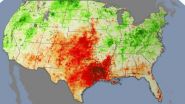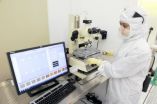(Press-News.org) In July 2012, farmers in the U.S. Midwest and Plains regions watched crops wilt and die after a stretch of unusually low precipitation and high temperatures. Before a lack of rain and record-breaking heat signaled a problem, however, scientists observed another indication of drought in data from NASA and NOAA satellites: plant stress.
Healthy vegetation requires a certain amount of water from the soil every day to stay alive, and when soil moisture falls below adequate levels, plants become stressed. Scientists with the U.S. Department of Agriculture's Agricultural Research Service (USDA-ARS) have developed a way to use satellite data to map that plant stress. The maps could soon aid in drought forecasts, and prove useful for applications such as crop yield estimates or decisions about crop loss compensation.
"Crop drought monitoring is of high practical value, and any advance notice of drought conditions helps the farmer make practical decisions sooner," says Steve Running, an ecologist at University of Montana in Missoula.
A new animation of plant stress (top) shows how drought evolved across the United States from January 2010 through September 2012. In spring 2010, satellites measured cool leaf temperatures, indicating healthy plants and wetter-than-average conditions (green), over many areas across the country. By summer 2011, satellites saw the warming of stressed vegetation, indicating significantly lower-than-usual water availability (red) in many areas, most notably in Texas. Crops were either dead or would soon be dead.
Drought in 2012 was the most severe and extensive in at least 25 years, according to the USDA's Economic Research Service. By August 60 percent of farms were in areas experiencing drought, and by mid-September USDA had designated more than 2,000 counties as disaster areas. "2012 was record-breaking, this was just a huge event," says Martha Anderson with USDA-ARS in Beltsville, Md., who is working with a team to develop the plant stress indicator for drought and presented the research Dec. 5, at the American Geophysical Union meeting in San Francisco.
The 2012 event is what experts call a flash drought, meaning that it evolved quickly and unexpectedly. Low soil moisture was further depleted by the heat wave that started in May, and drought abruptly followed. By about May 5 the core regions of drought began to appear on the plant stress map – earlier than the signs of drought appeared in other indicators, such as rainfall measurements.
"We think there's some early-warning potential with these plant stress maps, alerting us as the crops start to run out of water," Anderson says. Signals of plant stress may often appear first in satellite-derived maps of vegetation temperature before the crops have actually started to wilt and die. "The earlier we can learn things are turning south, presumably the more time we have to prepare for whatever actions might be taken."
For example, farmers may decide they need to buy supplemental feed from outside the drought-affected area to support their livestock, or they may need to adjust contract or insurance decisions.
The U.S. Drought Monitor already uses a combination of indices, such as rainfall, to describe drought conditions each week. The monitor currently does not include plant stress, but the potential is being explored. "Plant stress is one representation of drought impacts, and the drought monitoring community agrees that you can't do this with just one tool – you need a lot of different tools," Anderson says.
Plant stress information has the potential to improve the skill of existing forecasts that predict drought out to weeks or months. Also, because the plant stress information is derived from satellites, it can describe drought conditions in areas where rain gauge and radar networks are sparse -- and it can do so at the scale of individual fields.
VIDEO:
A new animation of plant stress shows how drought evolved across the United States from January 2010 through September 2012.
Click here for more information.
To produce the maps of plant stress, scientists start with the Moderate Resolution Imaging Spectroradiometer (MODIS) on NASA's Terra and Aqua satellites. Images are processed to distinguish between land surfaces covered by soil and surfaces covered with vegetation.
Narrowing their focus to vegetated areas, scientists set out to measure moisture availability. Plants cool themselves by sweating water extracted from the soil by their roots. When access to water is limited, plants lessen their consumption and reduce evapotranspiration from leaf surfaces. As a result, leaves heat up and produce an elevated leaf or canopy temperature, which can be detected by thermal sensors on NOAA's geostationary weather satellites. Hotter plants imply limited water in the soil.
"This is not a drought forecast. It's a map of what's going on right now," Anderson says. "Is there more or less water than usual?"
What is "usual" or normal, however, can depend on the season or even the year. Scientists currently define normal by calculating and mapping plant stress averaged over periods of 1-3 months, from the start of MODIS data collection in 2000 to present. The mean of these historic maps is considered normal. Compare a current map with the longer-term "normal" map, and scientists get a picture of the magnitude by which current conditions deviate from normal.
"What was normal back in 1920 is not what's normal now, so the more years we have under the belt the better we can define normal," Anderson says. "But this year is so far out of line with respect to previous years, it is unusual regardless of the period of record used as the baseline."
INFORMATION:
Related Links:
NASA at the American Geophysical Union meeting
http://www.nasa.gov/agu
Drought: The Creeping Disaster
http://earthobservatory.nasa.gov/Features/DroughtFacts/drought_facts.php
NASA MODIS
http://modis.gsfc.nasa.gov
USDA Agricultural Research Service
http://www.ars.usda.gov/main/main.htm
Plant stress paints early picture of drought
2012-12-06
ELSE PRESS RELEASES FROM THIS DATE:
NASA investigates use of 'trailblazing' material for new sensors
2012-12-06
Tiny sensors -- made of a potentially trailblazing material just one atom thick and heralded as the "next best thing" since the invention of silicon -- are now being developed to detect trace elements in Earth's upper atmosphere and structural flaws in spacecraft.
Technologist Mahmooda Sultana, who joined NASA's Goddard Space Flight Center in Greenbelt, Md., two years ago and has since emerged as Goddard's go-to expert in the development of graphene-based technology, has expanded her portfolio to include two new research and development efforts aimed at creating nano-sized ...
Site-specific, long-term research expanding understanding of climate change
2012-12-06
DURHAM, N.H., Dec. 5, 2012 – While science has often focused on big-scale, global climate change research, a study recently published in the journal Bioscience suggests that long-term, integrated and site-specific research is needed to understand how climate change affects multiple components of ecosystem structure and function, sometimes in surprising ways.
"Long-term ecological research is important to understanding the effects of a changing climate on our natural resources and so much more," said Michael T. Rains, Director of the Forest Service's Northern Research Station. ...
Experts available to discuss new paper detailing global sea level rise scenario
2012-12-06
On December 6, NOAA will release a technical report that estimates global mean sea level rise over the next century based on a comprehensive synthesis of existing scientific literature. The report finds that there is very high confidence (greater than 90% chance) that global mean sea level will rise at least 8 inches (0.2 meters) and no more than 6.6 feet (2 meters) by 2100, depending upon uncertainties associated with ice sheet loss and ocean warming.
The actual amount of sea level change at any one region and location greatly varies in response to regional and local ...
Biologists unlocking the secrets of plant defenses, 1 piece at a time
2012-12-06
Researchers examining how the hormone jasmonate works to protect plants and promote their growth have revealed how a transcriptional repressor of the jasmonate signaling pathway makes its way into the nucleus of the plant cell.
They hope the recently published discovery will eventually help farmers experience better crop yields with less use of potentially harmful chemicals.
"This is a small piece of a bigger picture, but it is a very important piece," said Maeli Melotto, a University of Texas at Arlington assistant professor of biology.
Melotto recently co-authored ...
Military/Veteran Medical Malpractice Claims Are An Uphill Battle
2012-12-06
Military/Veteran medical malpractice claims are an uphill battle
Some of the highest courts in the land -- the United States Supreme Court among them -- will soon be hearing cases involving the niche area of military malpractice claims. Military physicians usually enjoy "sovereign immunity" (essentially making them immune from many types of lawsuits) in their capacity as physicians working for the government.
These cases do not argue the validity of sovereign immunity, but instead question its applicability in even the most egregious military medical malpractice ...
Could Patient Photos Reduce Serious Medical Errors?
2012-12-06
Could patient photos reduce serious medical errors?
A study by researchers at a Colorado hospital found that including photos in patients' electronic medical records helps reduce serious medical mistakes known as "wrong-patient errors." Implementing electronic record systems with photos at hospitals across the country may help improve the national rate of serious medical errors.
Researchers find using a photo drastically reduces number of errors
In 2009, Children's Hospital Colorado found that misplaced orders in electronic files was the second-most common ...
Potential Pitfalls When Keeping The Home After Divorce
2012-12-06
Potential pitfalls when keeping the home after divorce
One of the most common disagreements among divorcing couples, along with issues of child custody and alimony, is who gets to keep the house. While it is perfectly understandable to be reluctant to give up one's home, people going through divorce should be aware of some hidden costs they may not be expecting if they decide to keep the house.
Maintenance and repair costs
One common unexpected pitfall occurs when the spouse who keeps the home has not accurately estimated the monthly expenses involved in maintaining ...
How Will Divorce Affect My Business In Colorado?
2012-12-06
How will divorce affect my business in Colorado?
For many people going through a divorce, one of the most difficult steps in the divorce process is dividing up shared property such as the family home, vehicles, savings accounts and other valuables. When one or both spouses are business owners, the property division process can become even more complicated and potentially volatile. Business owners in Colorado should be aware of how their business assets may be treated in the event of divorce and take steps to protect them in case such a situation should arise.
Division ...
Prenuptial And Postnuptial Agreements On The Rise
2012-12-06
Prenuptial and postnuptial agreements on the rise
To love, honor, and keep all property separate? With divorce rates continuing to hover around 50 percent throughout the country, more and more couples are using contracts to outline what assets belong to which spouse.
Some are using agreements set up prior to the wedding, called a prenuptial agreement, while others are outlining the terms after the wedding, called a postnuptial agreement. These contracts can help ease financial stress between couples by clearly outlining how assets will be split if the marriage fails.
Although ...
Divorce And Insurance: Knowing How It Is Split Can Help Save Headaches
2012-12-06
Divorce and insurance: knowing how it is split can help save headaches
Divorce is difficult for every couple. Couples must come to terms with the fact that a romantic relationship is ending while also dealing with how assets will be split. In addition to balancing these issues, couples should also keep in mind that their insurance will likely be impacted by the divorce.
First and foremost, it is important to know that once a Petitioner for Marital Dissolution (a divorce) is filed in California, the party who filed it (the Petitioner) may not cancel or change the beneficiaries ...

